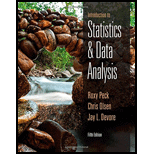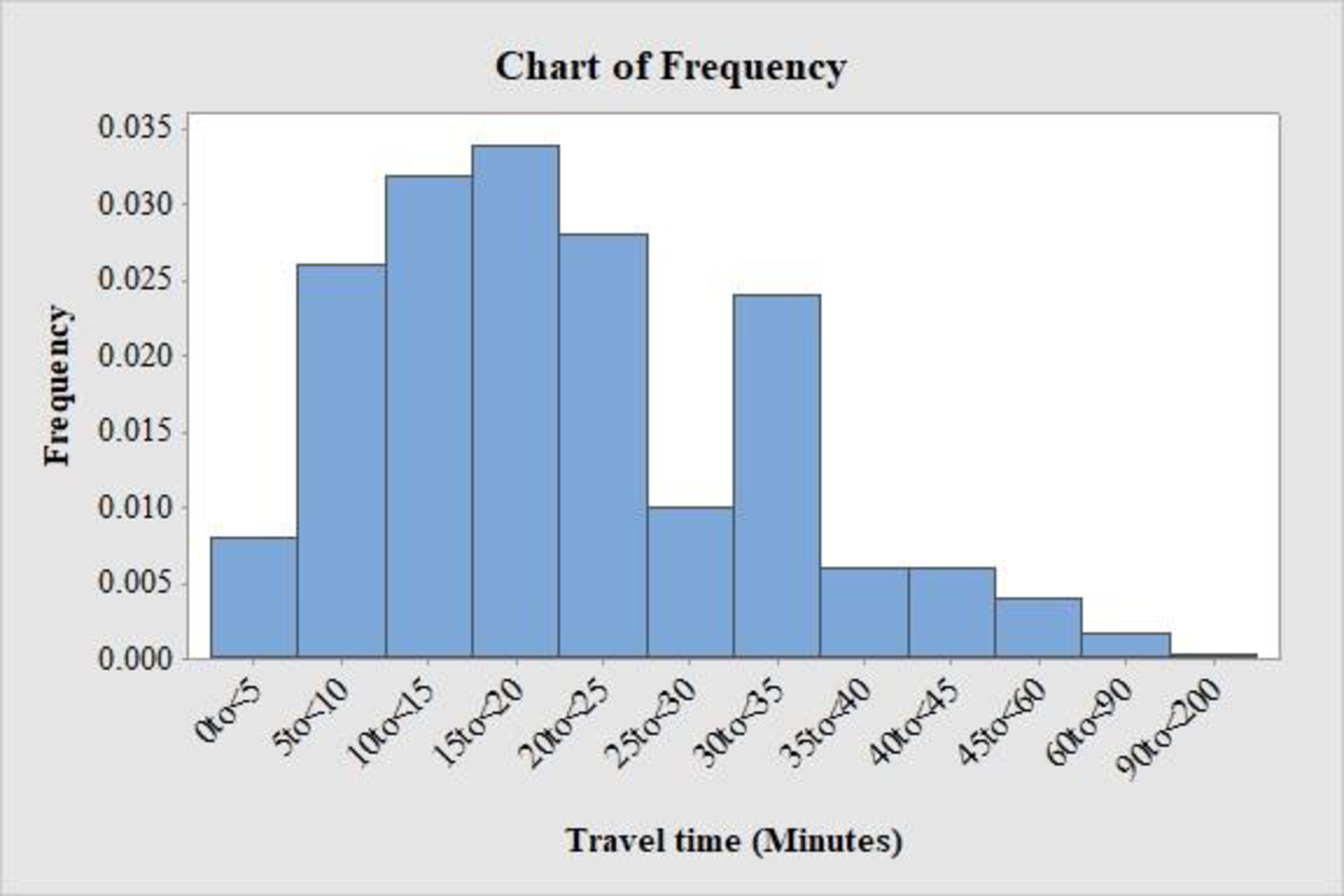
a.
Draw a histogram for the travel time distribution.
a.
Answer to Problem 40E
The histogram for the travel time distribution is given below:

Explanation of Solution
Calculation:
The data represent the relative frequency for travel time to work for a large sample of adults who did not work at home.
Software procedure:
Step-by-step procedure to obtain the width using MINITAB software:
- Choose Calc > Calculator.
- Enter the column of width under Store result in variable.
- Enter the formula ‘Upper’-‘Lower’ under Expression.
- Click OK.
The
Step-by-step procedure to obtain the density using MINITAB software:
- Choose Calc > Calculator.
- Enter the column of Frequency under Store result in variable.
- Enter the formula ‘Frequency’/‘width’ under Expression.
- Click OK.
The density is stored in the column “Frequency”.
Step by step procedure to draw the relative frequency histogram using MINITAB software:
- Select Graph > Bar chart.
- In Bars represent select Values from a table.
- In One column of values select Simple.
- Enter Frequency in Graph variables.
- Enter Travel Time (Minutes) in categorical variable.
- Select OK.
- Click on the axis of the graph and in Gap between clusters enter 0.
Thus, the histogram for travel time is obtained.
b.
Delineate the features, such as center, shape, and variability of the histogram from Part (a).
b.
Explanation of Solution
From the histogram, it is observed that the distribution of travel time is slightly positively skewed with a single maximum frequency density, that is, a single
c.
Explain whether it is appropriate to use the
c.
Answer to Problem 40E
No, it is not appropriate to use empirical rule to make statements about the travel time distribution.
Explanation of Solution
By observing the histogram, the travel time data are skewed right. However, the empirical rule is applicable for data that are distributed normally, which is bell-shaped and symmetric.
Therefore, in this context, it is not appropriate to use the empirical rule to make the statements about the travel time distribution.
d.
Elucidate the reason why the travel time distribution could not be well approximated by a normal curve.
d.
Explanation of Solution
It is given that the approximate
The observation of the travel time should not be negative. In general, the travel time begins from 0.
If the distribution of the travel time is approximately normal, then the percentage of the travel time that fall below 0 is obtained as given below:
Use the standard normal probabilities (cumulative z-curve area) table to find the z-value:
Procedure:
For z at –1.12:
- Locate –1.1 in the left column of the table.
- Obtain the value in the corresponding row below 0.02.
That is,
Therefore, the percentage of the travel time that fall below 0 is 13.14% that is not possible.
Hence, the distribution of the travel time cannot be approximated by the normal curve.
e.
Find the percentage of travel time between 0 and 75 minutes using Chebyshev’s rule.
Obtain the percentage of travel time between 0 and 47 minutes using Chebyshev’s rule.
e.
Answer to Problem 40E
The percentage of travel time between 0 and 75 minutes is at least 75%.
The percentage of travel time between 0 and 47 minutes is at least 21%.
Explanation of Solution
Calculation:
The approximate mean and standard deviation for the travel time distribution are 27 minutes and 24 minutes, respectively.
The values at 2 standard deviations away from the mean is obtained as follows:
The observation of the travel time should not be negative. Therefore, the travel time that begins at –21 minutes lies in 2 standard deviation below the mean that is not possible. Travel time 75 minutes lies 2 standard deviations above from the mean.
Chebyshev’s rule:
For any number k, where
The z-score gives the number of standard deviations that an observation of 75 minutes is away from the mean. Here, the z-scores for 0 minutes and 75 minutes are –2 and 2, respectively. Thus, these observations of time are 2 standard deviations from the mean that is
(i).
The percentage of travel time between 0 and 75 minutes is obtained as given below:
Use Chebyshev’s rule as follows:
In this context, at least 0.75 proportion of observations lie within 2 standard deviations of the mean.
Therefore, the percentage of travel time between 0 and 75 minutes is 75%.
(ii).
A travel time of 47 minutes is
A travel time of 0 minutes is
Since 1.125 is larger than 0.833, these observations of time are 1.125 standard deviations from the mean that is
The percentage of the travel times between 0 and 47 minutes is obtained as given below:
Use Chebyshev’s rule as follows:
Thus, the percentage of the travel time between 0 and 47 minutes is 21%.
f.
Explain the way why the statements in Part (e) agree with the actual percentage for the travel time distribution.
f.
Explanation of Solution
Calculation:
The actual percentage of travel time between 0 and 75 minutes is obtained as given below:
Therefore, the actual percentage of travel time between 0 and 75 minutes is approximately 95.5% and differs a lot from the percentage obtained using Chebyshev’s rule.
The actual percentage of travel times between 0 and 47 minutes is obtained as given below:
Therefore, the actual percentage of travel time between 0 and 47 minutes is approximately 90% and differs a lot from the percentage obtained using Chebyshev’s rule.
Want to see more full solutions like this?
Chapter 4 Solutions
Introduction to Statistics and Data Analysis
- The following ordered data list shows the data speeds for cell phones used by a telephone company at an airport: A. Calculate the Measures of Central Tendency from the ungrouped data list. B. Group the data in an appropriate frequency table. C. Calculate the Measures of Central Tendency using the table in point B. 0.8 1.4 1.8 1.9 3.2 3.6 4.5 4.5 4.6 6.2 6.5 7.7 7.9 9.9 10.2 10.3 10.9 11.1 11.1 11.6 11.8 12.0 13.1 13.5 13.7 14.1 14.2 14.7 15.0 15.1 15.5 15.8 16.0 17.5 18.2 20.2 21.1 21.5 22.2 22.4 23.1 24.5 25.7 28.5 34.6 38.5 43.0 55.6 71.3 77.8arrow_forwardII Consider the following data matrix X: X1 X2 0.5 0.4 0.2 0.5 0.5 0.5 10.3 10 10.1 10.4 10.1 10.5 What will the resulting clusters be when using the k-Means method with k = 2. In your own words, explain why this result is indeed expected, i.e. why this clustering minimises the ESS map.arrow_forwardwhy the answer is 3 and 10?arrow_forward
- PS 9 Two films are shown on screen A and screen B at a cinema each evening. The numbers of people viewing the films on 12 consecutive evenings are shown in the back-to-back stem-and-leaf diagram. Screen A (12) Screen B (12) 8 037 34 7 6 4 0 534 74 1645678 92 71689 Key: 116|4 represents 61 viewers for A and 64 viewers for B A second stem-and-leaf diagram (with rows of the same width as the previous diagram) is drawn showing the total number of people viewing films at the cinema on each of these 12 evenings. Find the least and greatest possible number of rows that this second diagram could have. TIP On the evening when 30 people viewed films on screen A, there could have been as few as 37 or as many as 79 people viewing films on screen B.arrow_forwardQ.2.4 There are twelve (12) teams participating in a pub quiz. What is the probability of correctly predicting the top three teams at the end of the competition, in the correct order? Give your final answer as a fraction in its simplest form.arrow_forwardThe table below indicates the number of years of experience of a sample of employees who work on a particular production line and the corresponding number of units of a good that each employee produced last month. Years of Experience (x) Number of Goods (y) 11 63 5 57 1 48 4 54 5 45 3 51 Q.1.1 By completing the table below and then applying the relevant formulae, determine the line of best fit for this bivariate data set. Do NOT change the units for the variables. X y X2 xy Ex= Ey= EX2 EXY= Q.1.2 Estimate the number of units of the good that would have been produced last month by an employee with 8 years of experience. Q.1.3 Using your calculator, determine the coefficient of correlation for the data set. Interpret your answer. Q.1.4 Compute the coefficient of determination for the data set. Interpret your answer.arrow_forward
- Can you answer this question for mearrow_forwardTechniques QUAT6221 2025 PT B... TM Tabudi Maphoru Activities Assessments Class Progress lIE Library • Help v The table below shows the prices (R) and quantities (kg) of rice, meat and potatoes items bought during 2013 and 2014: 2013 2014 P1Qo PoQo Q1Po P1Q1 Price Ро Quantity Qo Price P1 Quantity Q1 Rice 7 80 6 70 480 560 490 420 Meat 30 50 35 60 1 750 1 500 1 800 2 100 Potatoes 3 100 3 100 300 300 300 300 TOTAL 40 230 44 230 2 530 2 360 2 590 2 820 Instructions: 1 Corall dawn to tha bottom of thir ceraan urina se se tha haca nariad in archerca antarand cubmit Q Search ENG US 口X 2025/05arrow_forwardThe table below indicates the number of years of experience of a sample of employees who work on a particular production line and the corresponding number of units of a good that each employee produced last month. Years of Experience (x) Number of Goods (y) 11 63 5 57 1 48 4 54 45 3 51 Q.1.1 By completing the table below and then applying the relevant formulae, determine the line of best fit for this bivariate data set. Do NOT change the units for the variables. X y X2 xy Ex= Ey= EX2 EXY= Q.1.2 Estimate the number of units of the good that would have been produced last month by an employee with 8 years of experience. Q.1.3 Using your calculator, determine the coefficient of correlation for the data set. Interpret your answer. Q.1.4 Compute the coefficient of determination for the data set. Interpret your answer.arrow_forward
 Big Ideas Math A Bridge To Success Algebra 1: Stu...AlgebraISBN:9781680331141Author:HOUGHTON MIFFLIN HARCOURTPublisher:Houghton Mifflin Harcourt
Big Ideas Math A Bridge To Success Algebra 1: Stu...AlgebraISBN:9781680331141Author:HOUGHTON MIFFLIN HARCOURTPublisher:Houghton Mifflin Harcourt Holt Mcdougal Larson Pre-algebra: Student Edition...AlgebraISBN:9780547587776Author:HOLT MCDOUGALPublisher:HOLT MCDOUGAL
Holt Mcdougal Larson Pre-algebra: Student Edition...AlgebraISBN:9780547587776Author:HOLT MCDOUGALPublisher:HOLT MCDOUGAL Functions and Change: A Modeling Approach to Coll...AlgebraISBN:9781337111348Author:Bruce Crauder, Benny Evans, Alan NoellPublisher:Cengage Learning
Functions and Change: A Modeling Approach to Coll...AlgebraISBN:9781337111348Author:Bruce Crauder, Benny Evans, Alan NoellPublisher:Cengage Learning Glencoe Algebra 1, Student Edition, 9780079039897...AlgebraISBN:9780079039897Author:CarterPublisher:McGraw Hill
Glencoe Algebra 1, Student Edition, 9780079039897...AlgebraISBN:9780079039897Author:CarterPublisher:McGraw Hill College Algebra (MindTap Course List)AlgebraISBN:9781305652231Author:R. David Gustafson, Jeff HughesPublisher:Cengage Learning
College Algebra (MindTap Course List)AlgebraISBN:9781305652231Author:R. David Gustafson, Jeff HughesPublisher:Cengage Learning Mathematics For Machine TechnologyAdvanced MathISBN:9781337798310Author:Peterson, John.Publisher:Cengage Learning,
Mathematics For Machine TechnologyAdvanced MathISBN:9781337798310Author:Peterson, John.Publisher:Cengage Learning,





